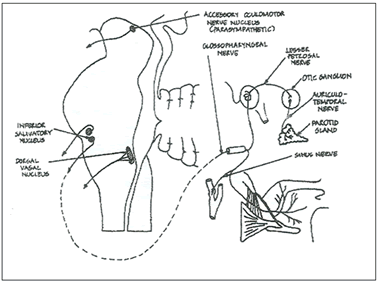| THE GLOSSOPHARYNGEAL NERVE (CN IX) |
|
|
|
| The Origin(s) and functional components |
- Gustatory nucleus: SVA fibres from the posterior third of the tongue and rudimentary taste buds in the pharynx.
- Solitary nucleus: GVA fibres from the posterior third of the tongue, pharynx and carotid sinus.
- Spinal nucleus of the trigeminal nerve: GSA fibres from the pinna of the ear and the external auditory meatus.
- Nucleus ambiguus: SVE, branchiomotor, fibres to the stylopharyngeus muscle
- Inferior salivatory nucleus: pre-ganglionic parasympathetic, GVE fibres, to the parotid gland.
|
|
| The Course and distribution

|
- Emerges from the brain stem as a series of five or six small nerve rootlets, immediately dorsal to the inferior olive.
- Rootlets emerge rostral to the vagus nerve rootlets
- Exits through the jugular foramen and emerges immediately posterior to the styloid process.
- It has two ganglia superior (GSA) , and the inferior ( GVA and SVA).
|
|
Branches |
Distribution |
Tympanic nerve
|
- Tympanic cavity
- Auditory tube
- Otic ganglion
|
|
Auricular branch
|
- Small area on the pinna of the ear
- External auditory meatus.
|
|
| Nerve to stylopharyngeus (SVE) |
|
|
| Carotid sinus branch (GVA) |
- Carotid sinus
- Carotid body
|
|
| Pharyngeal nerve |
- posterior third of the tongue, providing both SVA (taste) and GVA innervation.
- Oro-pharyngeal mucosa
|
|
|
| Functional Components |
| |
| |
Clinical disorders of Glossopharyngeal nerve
A lesion affecting only the glossopharyngeal nerve is rare. It is characterised by:
- The loss of (or reduction in) the gag reflex usually elicited by stroking the lateral wall of the pharynx near the tonsilar fossa.
- loss of taste sensation on the ipsilateral posterior third of the tongue
,
- marked reduction in the serous secretion of the ipsilateral parotid gland.
|